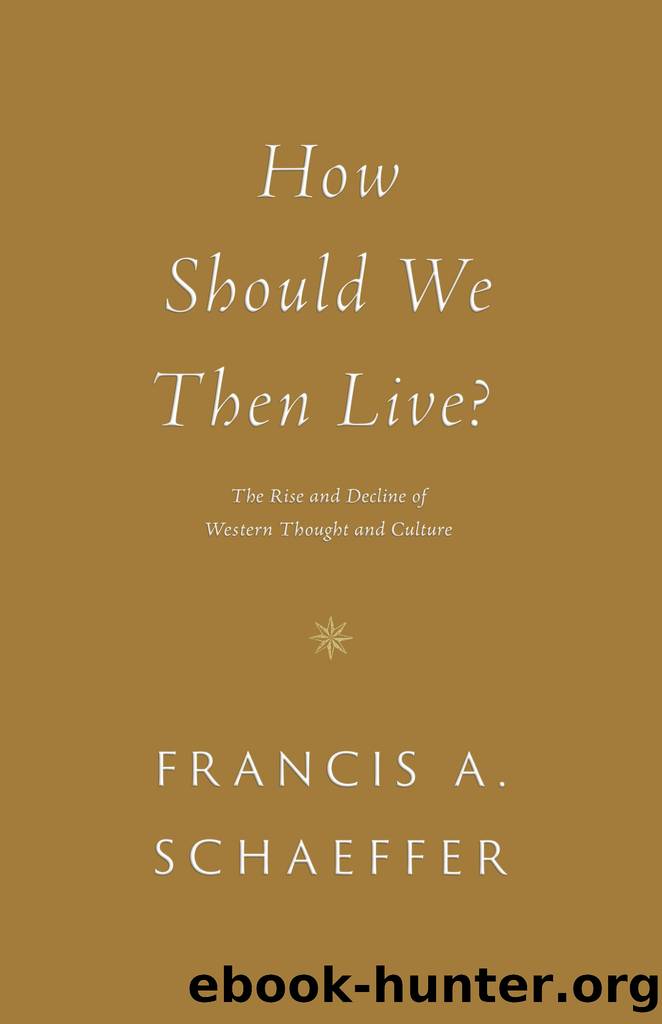How Should We Then Live? by Unknown

Author:Unknown
Language: eng
Format: epub
Tags: REL067030/REL070000/REL067000
Publisher: Crossway
Published: 2022-03-22T00:00:00+00:00
Plate 48 Salvador DalÃ, The Sacrament of the Last Supper, 1955, oil on canvas, National Gallery of Art, Washington, DC. â. . . Christ is an upper-story, mystical figure.â
Dalà explained in his interviews that he had found a mystical meaning for life in the fact that things are made up of energy rather than solid mass. Because of this, for him there was a reason for a vault into an area of nonreason to give him the hope of meaning. Whether in his interviews or in these paintings, that which causes him to escape the absurdity which Surrealism presented is not reason, and it is not Christianity either; it is a blind leap into the area of nonreason.
One must understand that from the advent of Kierkegaardianism onward there has been a widespread concept of the dichotomy between reason and nonreason, with no interchange between them. The lower-story area of reason is totally isolated from the optimistic area of nonreason. The line which divides reason from nonreason is as impassable as a concrete wall thousands of feet thick, reinforced with barbed wire charged with 10,000 volts of electricity. There is no interchange, no osmosis between the two parts. So modern man now lives in such a total dichotomy, wherein reason leads to despair. âDownstairsâ in the area of humanistic reason, man is a machine, man is meaningless. There are no values. And âupstairsâ optimism about meaning and values is totally separated from reason. Reason has no place here at all; here reason is an outcast.
This division into these two areas is the existential methodology. This methodology (and the existence of the dichotomy) is the hallmark of the modern stream of humanistic thinking. Once people adopt this dichotomyâwhere reason is separated totally from nonreasonâthey must then face the fact that many types of things can be put in the area of nonreason. And it really does not matter what one chooses to put there, because reason gives no basis for a choice between one thing or another.
In addition to the secular existentialism of Sartre, Camus, Jaspers, and Heidegger, Kierkegaardianism brought forth another form of existentialism: the theological existentialism which began with Karl Barth (1886â1968), especially with his first commentary (1919) on the New Testament book entitled The Epistle to the Romans. We must have profound admiration for Karl Barth in that he, as a Swiss teaching in Germany, made a public stand against Nazism in the Barman Declaration of 1934. For many years he taught at the University of Basel, was a prolific writer, and has had a profound effect on the general flow of theology and intellectual thought in this generation. But in his theology Karl Barth made his own kind of dichotomy and brought the existential methodology into theology.
Back in the Middle Ages we saw that certain humanistic elements entered the church. The essence of the Reformation was the removal of these from the churchâs teaching. On the other hand, humanistic thinking developed in the Renaissance and again went further in the Enlightenment.
Download
This site does not store any files on its server. We only index and link to content provided by other sites. Please contact the content providers to delete copyright contents if any and email us, we'll remove relevant links or contents immediately.
| Buddhism | Christianity |
| Ethnic & Tribal | General |
| Hinduism | Islam |
| Judaism | New Age, Mythology & Occult |
| Religion, Politics & State |
Cecilia; Or, Memoirs of an Heiress — Volume 1 by Fanny Burney(32434)
Cecilia; Or, Memoirs of an Heiress — Volume 2 by Fanny Burney(31871)
Cecilia; Or, Memoirs of an Heiress — Volume 3 by Fanny Burney(31852)
The Secret History by Donna Tartt(18845)
Sapiens: A Brief History of Humankind by Yuval Noah Harari(14250)
Leonardo da Vinci by Walter Isaacson(13181)
The Radium Girls by Kate Moore(11921)
Sapiens by Yuval Noah Harari(5294)
How Democracies Die by Steven Levitsky & Daniel Ziblatt(5127)
The Wind in My Hair by Masih Alinejad(5033)
Homo Deus: A Brief History of Tomorrow by Yuval Noah Harari(4823)
Endurance: Shackleton's Incredible Voyage by Alfred Lansing(4676)
The Silk Roads by Peter Frankopan(4457)
Man's Search for Meaning by Viktor Frankl(4423)
Millionaire: The Philanderer, Gambler, and Duelist Who Invented Modern Finance by Janet Gleeson(4374)
The Rape of Nanking by Iris Chang(4137)
Joan of Arc by Mary Gordon(4013)
The Motorcycle Diaries by Ernesto Che Guevara(4012)
Hitler in Los Angeles by Steven J. Ross(3900)
